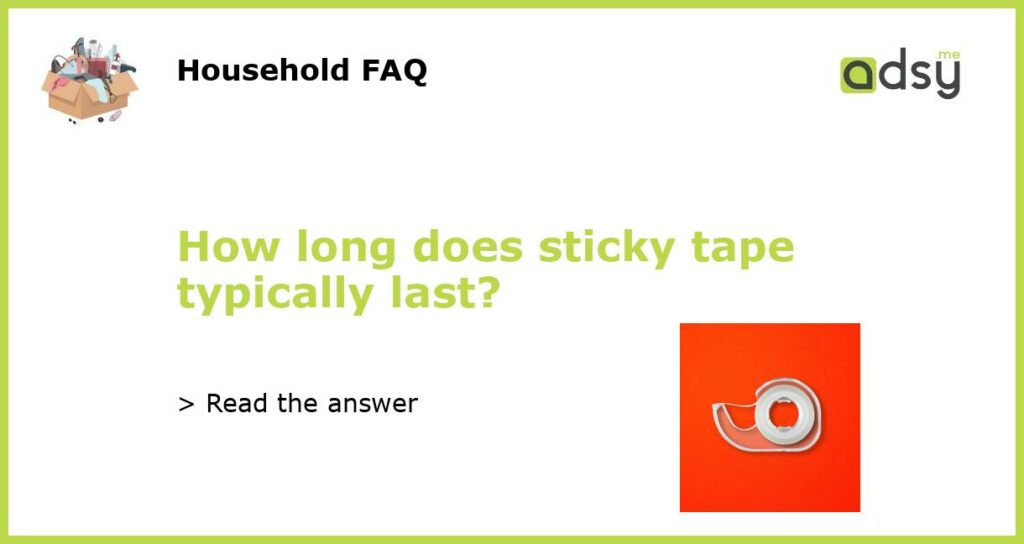The Basics of Sticky Tape
Sticky tape, also known as adhesive tape, is a widely used product in households, offices, and industrial settings. It is made up of a long strip of thin material, such as plastic or paper, coated with an adhesive on one side. The adhesive side is often covered with a protective release liner, which needs to be removed before the tape can be used.
The adhesive used in sticky tape can be pressure-sensitive, meaning it sticks to surfaces when pressure is applied, or it can be activated by heat or solvent. This versatility makes sticky tape suitable for various applications, including packaging, sealing, binding, and repairing.
Factors Affecting the Lifespan of Sticky Tape
The lifespan of sticky tape varies depending on several factors. First and foremost, the quality of the tape plays a significant role. Higher-quality tapes are generally more durable and long-lasting compared to cheaper alternatives. Additionally, the type of adhesive used can affect longevity. Some adhesives are designed to remain sticky for extended periods, while others may lose their adhesive properties more quickly.
The conditions in which the tape is used also impact its lifespan. For example, extreme temperatures, humidity, and exposure to UV light can degrade the adhesive and cause the tape to deteriorate faster. It is important to store and use sticky tape in suitable environments to maximize its longevity.
Furthermore, the type of surface on which the tape is applied can determine how long it will last. Smooth and clean surfaces provide better adhesion compared to rough or dirty surfaces. Surfaces that are oily or greasy can also reduce the tape’s ability to stick effectively.
Different Types of Sticky Tape and Their Durability
There are various types of sticky tape available in the market, each with its specific characteristics and durability.
– Packing Tape: Packing tape is designed to secure boxes and packages during transportation. It is generally made of durable materials like biaxially oriented polypropylene (BOPP) and has a strong adhesive that holds firmly. Depending on the brand and quality, packing tape can last for months.
– Masking Tape: Masking tape is commonly used in painting projects to protect areas from paint. It has a moderate adhesive strength and can be easily removed without leaving residue. Masking tape typically lasts for a few weeks.
– Duct Tape: Duct tape is known for its high strength and versatility. It is commonly used for repairs and temporary fixes. With its strong adhesive and durable construction, duct tape can last for several months, depending on the conditions in which it is used.
– Double-Sided Tape: Double-sided tape has adhesive on both sides, making it suitable for applications where visibility of the tape is not desired. Its durability depends on the brand and quality, with some lasting for weeks or even months.
Proper Usage and Storage to Prolong Lifespan
To ensure the sticky tape’s longevity, proper usage and storage are essential.
– Prepare the Surface: Before applying the tape, make sure the surface is clean, dry, and free from dust or grease. This will enhance the tape’s adhesion and prolong its lifespan.
– Apply and Press Firmly: When applying the tape, press it firmly onto the surface to ensure maximum contact and adhesion. This will help the tape stick more securely and last longer.
– Avoid Extreme Conditions: Extreme temperatures, high humidity, and prolonged exposure to UV light can degrade the adhesive and reduce the tape’s lifespan. Store and use the tape in suitable conditions to maintain its effectiveness.
– Store Properly: To prevent the tape from drying out or getting damaged, store it in a cool, dry place away from direct sunlight or heat sources. This will help preserve its adhesive properties.
When to Replace Sticky Tape
Despite its durability, sticky tape does not last forever. There are a few signs that indicate it is time to replace the tape:
– Loss of Adhesive: If the tape no longer sticks effectively and keeps coming off, it is a clear sign that the adhesive has worn out. Using a fresh roll of tape will ensure proper adhesion.
– Physical Damage: If the tape is torn, frayed, or damaged in any way, it may not provide adequate sealing or bonding. In such cases, it is best to replace it with a new piece of tape.
– Visible Deterioration: Over time, sticky tape may show signs of deterioration, such as discoloration, hardening, or cracking. These are indicators that the tape is past its prime and may not perform as intended.
By paying attention to these signs and following proper usage and storage practices, you can maximize the lifespan of sticky tape and ensure its effectiveness for various applications.






